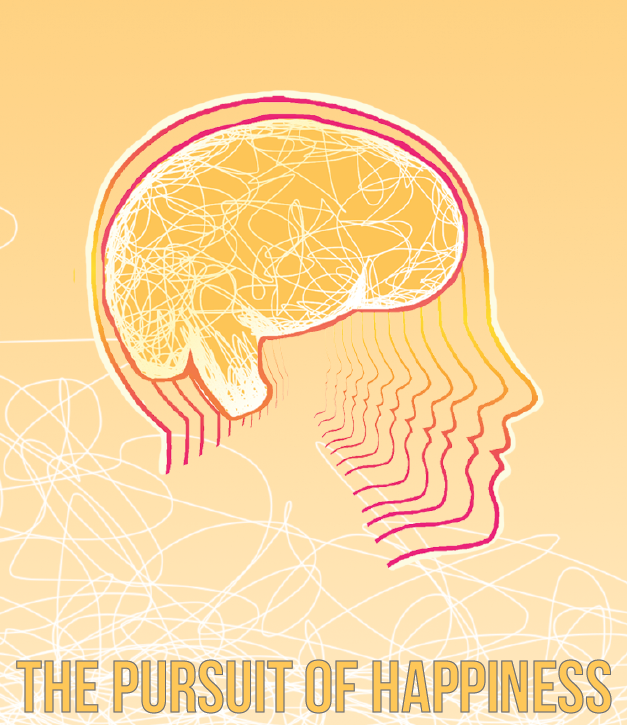Your donation will support the student journalists of Kirkwood High School. Your contribution will allow us to purchase equipment and cover our annual website hosting costs.
The pursuit of happiness
November 6, 2015
The right prefrontal cortex lights up the pleasure centers in the brain like a Christmas tree. Endorphins, oxytocin, serotonin and dopamine are released from the limbic system. These chemicals surge the brain, metabolize and fill the large human cortex. They overwhelm the bad feelings by triggering and producing more feel-good chemicals. This is the brain on happiness.
Happiness is often defined in terms of external factors, however, the internal neurochemistry of the brain is a driving force behind feelings of euphoria. I took a look at how to chase these happy chemicals in a person’s pursuit of happiness.
With these inherent neuro behaviors, it may seem easy to sit along and play out the process, but according to Angela Scheer, psychology teacher, one can take control of their own happiness. By affecting the balance in the brain and overriding neurochemicals, you can work experiences into your daily life to increase happy chemicals. These four main ‘feel-good’ neurochemicals – endorphins, oxytocin, serotonin and dopamine – can be wagered and boosted in order to achieve a happier life.
“The field of positive psychology is studying how controlling our thought process with cognitive behavioral therapy can lead to lower levels of depression and more happiness,” Scheer said.
Endorphins, or ‘self-produced morphine,’ are caused by pain. Just as morphine does, they diminish one’s perception of physical distress, according to WebMD. The ‘endorphin-high’ runners experience after a 7-minute mile is the result of pushing their body to a point of distress. Endorphins are produced during strenuous physical exertion as a way to recover. Laughing, which strains one’s face muscles, and stretching can even cause a release of endorphins, as a person’s insides become agitated and cause moderate wear and tear. Genuine laughing, yoga or Pilates, running, exercise and even crying all stimulate the right amount of pain needed to promote well-being.
Oxycontin is the “bonding molecule,” according to Psychology Today. It is released through proximity with others, or skin-to-skin contact, and creates a feeling of intimacy, trust and belonging. Social bonding, like eye contact or attentiveness, can also cultivate oxycontin. Simply hugging or even snuggling with your dog can cause oxycontin levels to rise. Intimate skin-to-skin contact, such as a massage, can boost oxycontin. In a world where most communication happens via iPhones, it is important to maintain face-to-face connections and human interaction, such as having lunch with friends, joining a club or going to a party.
Serotonin flows when a person feels important or safe and can be thought of as the confidence molecule. Serotonin controls one’s overall mood, as it is responsible for both good and bad moods, according to the Journal of Psychiatry & Neuroscience. Receiving respect from others boosts serotonin levels, however, be mindful of an innate urge for status. Develop this belief of self-worth and respect within yourself: enjoy who you are and take pride in your accomplishments. Reflecting on significant achievements or victories allows your brain to re-live the experience and produce serotonin. Also, interestingly, by getting some sunshine for 20 minutes, a person’s skin absorbs UV rays, thus promoting vitamin D and serotonin production.
Dopamine motivates a person to take action and encourages persistence to meet this goal. The anticipation of the reward triggers dopamine, causing the brain to release the necessary energy to move towards the reward. When the need is successfully met, you get another hit of pleasure. Stimulate this good feeling of dopamine by embracing new goals and breaking them down into achievable steps, so you can receive little hits of dopamine along the way to the ultimate finish line celebration.
Certainly, depression and bad moods can be the products of neurochemicals, but understanding and consciously altering them is a step closer to a happier you. Understanding what is going on in the brain and the jobs ‘happy chemicals’ have evolved to execute, allows one to influence the brain to their benefit and stimulate more euphoric chemicals. The brain is capable of change until the day a person dies, so start a new happy habit and with consistency you can shift the neurochemical balance in the brain. Get high on life with “happy highs.”

